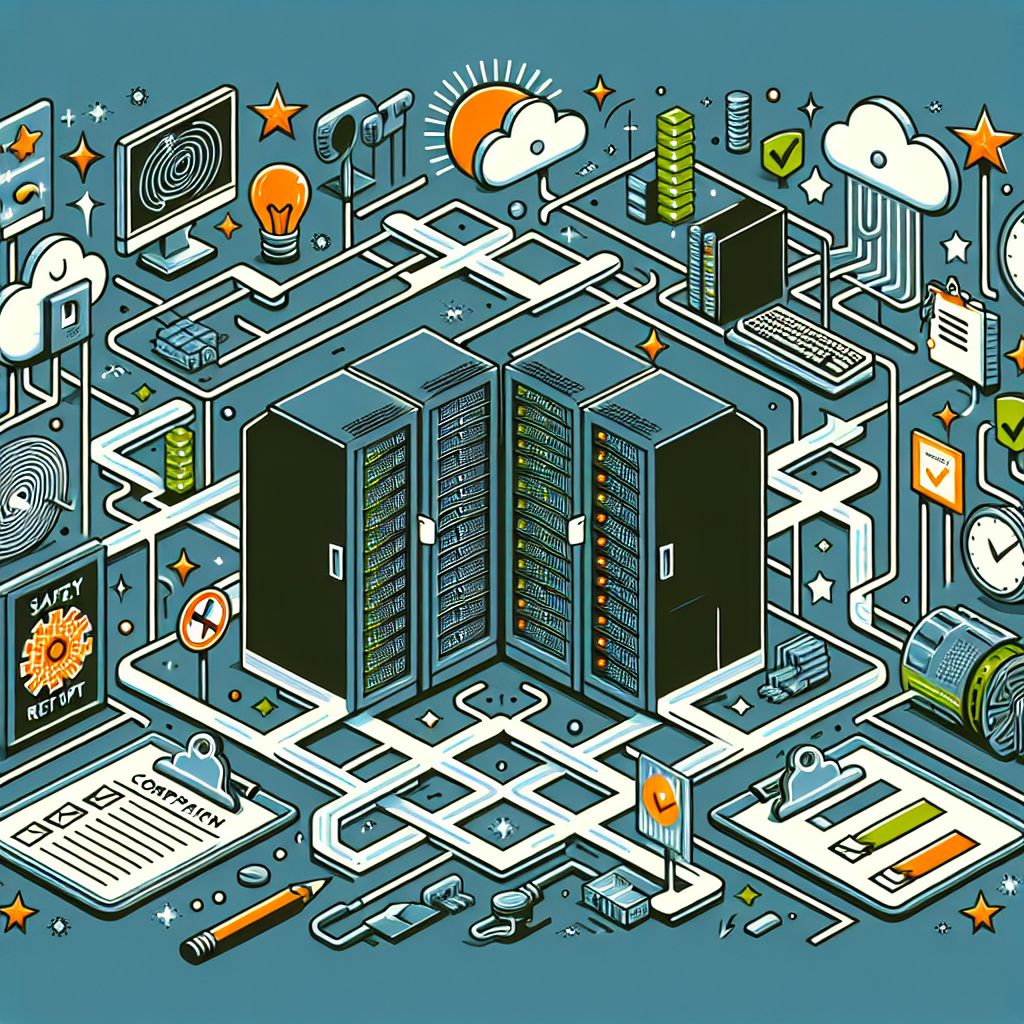Your cart is currently empty!
Tag: Navigating

Navigating Data Center Compliance: A Guide for Businesses
In today’s digital age, businesses are increasingly reliant on data centers to store and manage their valuable information. However, with this reliance comes a host of compliance regulations that must be adhered to in order to protect sensitive data and avoid legal repercussions. Navigating data center compliance can be a daunting task, but with the right knowledge and guidance, businesses can ensure that they are operating in a secure and compliant manner.One of the first steps in navigating data center compliance is understanding the various regulations that apply to your business. This can include industry-specific regulations such as HIPAA for healthcare organizations or GDPR for companies operating in the European Union. Additionally, there are general data protection regulations such as the California Consumer Privacy Act (CCPA) and the General Data Protection Regulation (GDPR) that apply to businesses worldwide.
Once you have a clear understanding of the regulations that apply to your business, the next step is to assess your current data center infrastructure and processes to ensure they are compliant. This may involve conducting a thorough audit of your data center operations, including assessing physical security measures, data encryption practices, and access controls. It is also important to review your data handling policies and procedures to ensure they align with compliance requirements.
In addition to ensuring your data center infrastructure is compliant, businesses must also consider the compliance of their cloud service providers. Many businesses rely on third-party cloud providers to store and manage their data, and it is essential to ensure that these providers are compliant with the relevant regulations. This may involve reviewing service level agreements, conducting security assessments, and ensuring that the provider has the necessary certifications and accreditations.
In order to maintain compliance with data center regulations, businesses must also implement robust data governance practices. This includes establishing clear policies and procedures for data handling, conducting regular security audits, and providing employee training on data security best practices. It is also important to monitor and track data access and usage to detect any unauthorized activities and prevent data breaches.
Finally, businesses must stay informed about changes in data center compliance regulations and adapt their practices accordingly. This may involve attending industry conferences, participating in training programs, and staying up to date on new developments in data security technology.
In conclusion, navigating data center compliance can be a complex and challenging task, but with the right knowledge and guidance, businesses can ensure that they are operating in a secure and compliant manner. By understanding the regulations that apply to your business, assessing your data center infrastructure, and implementing robust data governance practices, you can protect your sensitive data and avoid legal repercussions. Remember, compliance is not a one-time task, but an ongoing commitment to data security and regulatory adherence.

Navigating the Complexities of Data Center Power Distribution
Data centers are the backbone of the digital world, housing the servers and infrastructure that power our online activities. However, the smooth operation of these data centers relies heavily on an often-overlooked aspect – power distribution.Navigating the complexities of data center power distribution can be a daunting task, as it involves managing the flow of electricity to various components within the facility. From ensuring redundancy and reliability to optimizing efficiency and scalability, there are numerous factors to consider when designing and maintaining a data center’s power distribution system.
One of the key considerations in data center power distribution is redundancy. Redundancy is crucial to ensure uninterrupted power supply to critical equipment in the event of a power outage or equipment failure. This can be achieved through the use of dual power feeds, backup generators, and uninterruptible power supply (UPS) systems. By implementing redundant power distribution paths, data centers can minimize the risk of downtime and ensure continuous operation.
Another important aspect of data center power distribution is efficiency. With the increasing demand for computing power, data centers are under pressure to maximize the use of electricity while minimizing waste. This can be achieved through the use of energy-efficient power distribution equipment, such as transformers, switchgear, and power distribution units (PDUs). By optimizing the efficiency of their power distribution systems, data centers can reduce their energy consumption and operating costs.
Scalability is also a key consideration when designing a data center’s power distribution system. As data center requirements evolve and grow, the power distribution system must be able to accommodate changing needs. This can be achieved through modular and scalable power distribution solutions that can easily be expanded or upgraded as needed. By planning for scalability from the outset, data centers can future-proof their power distribution systems and avoid costly retrofitting or upgrades down the line.
In conclusion, navigating the complexities of data center power distribution requires careful planning and consideration of various factors, including redundancy, efficiency, and scalability. By investing in a robust power distribution system, data centers can ensure reliable operation, minimize downtime, and optimize energy efficiency. With the increasing importance of data centers in today’s digital economy, it is essential for organizations to prioritize power distribution as a critical component of their overall data center strategy.

Navigating Data Center Problem Management: Strategies for Success
In today’s fast-paced and technology-driven world, data centers play a crucial role in the operations of businesses and organizations. These facilities house and manage the critical IT infrastructure that enables businesses to store, process, and analyze large amounts of data. However, data centers are not immune to problems and challenges that can impact their performance and reliability. When issues arise, it is essential for data center managers to have a solid problem management strategy in place to address and resolve issues quickly and effectively.Navigating data center problem management can be a complex and challenging task, but with the right strategies and tools, it is possible to achieve success. Here are some key strategies for effectively managing problems in a data center:
1. Establish a Problem Management Process: The first step in effectively managing data center problems is to establish a clear and well-defined problem management process. This process should outline the steps that need to be taken when issues arise, including how to identify, categorize, prioritize, and resolve problems. By having a structured process in place, data center managers can ensure that problems are addressed in a timely and efficient manner.
2. Implement Monitoring and Alerting Tools: Monitoring and alerting tools are essential for proactively identifying and addressing potential problems in a data center. These tools can help data center managers track the performance and health of their infrastructure in real-time, allowing them to quickly identify and respond to issues before they escalate. By implementing monitoring and alerting tools, data center managers can stay ahead of potential problems and minimize downtime.
3. Collaborate with Stakeholders: Effective problem management requires collaboration and communication with stakeholders across the organization. Data center managers should work closely with IT teams, business units, vendors, and other stakeholders to ensure that everyone is aligned on problem resolution efforts. By fostering a culture of collaboration and transparency, data center managers can streamline problem management processes and drive better outcomes.
4. Document and Analyze Problem Data: Documentation is key to successful problem management in a data center. Data center managers should document all problem incidents, including the root cause, resolution steps, and any lessons learned. By analyzing problem data over time, data center managers can identify trends, recurring issues, and areas for improvement. This data-driven approach can help data center managers make informed decisions and implement proactive measures to prevent future problems.
5. Continuously Improve: Problem management is an ongoing process that requires continuous improvement and optimization. Data center managers should regularly review and evaluate their problem management processes, tools, and strategies to identify areas for improvement. By incorporating feedback from stakeholders, analyzing performance metrics, and implementing best practices, data center managers can continuously improve their problem management capabilities and drive better outcomes.
In conclusion, navigating data center problem management requires a strategic and proactive approach. By establishing a clear problem management process, implementing monitoring and alerting tools, collaborating with stakeholders, documenting and analyzing problem data, and continuously improving, data center managers can effectively address and resolve issues in their facilities. By following these strategies for success, data center managers can minimize downtime, improve performance, and ensure the reliability of their IT infrastructure.

Navigating Data Center Change Management: Best Practices and Strategies
In today’s fast-paced business environment, data centers play a crucial role in supporting critical business operations. As technology continues to evolve, data centers are constantly undergoing changes to keep up with the latest trends and advancements. However, managing these changes can be a complex and challenging process that requires careful planning and execution. In this article, we will explore best practices and strategies for navigating data center change management to ensure a smooth and successful transition.1. Establish a clear change management process: To effectively manage data center changes, it is essential to have a well-defined and structured change management process in place. This process should outline the steps involved in planning, implementing, and testing changes to minimize disruptions and ensure the stability and reliability of the data center environment.
2. Identify and assess risks: Before implementing any changes, it is important to identify and assess potential risks that could impact the data center operations. This includes evaluating the potential impact of the changes on system performance, security, and availability. By understanding the risks involved, organizations can develop mitigation strategies to address potential issues before they occur.
3. Communicate effectively: Effective communication is key to successful change management. It is essential to keep all stakeholders informed and updated throughout the change process, including IT teams, business leaders, and end-users. By keeping everyone informed and engaged, organizations can minimize resistance to change and ensure a smooth transition.
4. Test changes in a controlled environment: Before implementing changes in the production environment, it is important to test them in a controlled environment to identify any potential issues or conflicts. This allows organizations to address any issues before they impact the production environment and ensures a smooth transition.
5. Monitor and measure the impact of changes: After implementing changes, it is important to monitor and measure their impact on the data center environment. This includes monitoring performance metrics, system availability, and user feedback to ensure that the changes have been successful and meet the desired objectives. By monitoring the impact of changes, organizations can quickly identify and address any issues that arise.
6. Continuously improve and adapt: Change management is an ongoing process that requires continuous improvement and adaptation. It is important to regularly review and update the change management process to incorporate lessons learned and best practices. By continuously improving and adapting the change management process, organizations can effectively navigate data center changes and ensure the stability and reliability of their data center environment.
In conclusion, navigating data center change management requires careful planning, effective communication, and a structured process. By following best practices and strategies, organizations can successfully manage data center changes and ensure a smooth and successful transition. By establishing a clear change management process, identifying and assessing risks, communicating effectively, testing changes in a controlled environment, monitoring and measuring the impact of changes, and continuously improving and adapting the process, organizations can navigate data center changes with confidence and achieve their desired outcomes.
